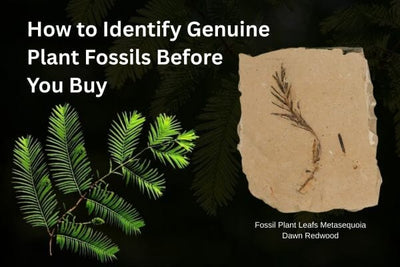Fossilized plants give us a good look into old ecosystems. They preserve millions of years of plant history. When you buy plant fossils online, it is important to know how to spot real fossils. That way, your collection will be worth something to science, stand out, and have true historical value.
Learn about the way the fossils take shape, the patterns in the minerals, and the place in the ground where they come from. This will make your collecting better and help you feel closer to ancient life.
Understanding Genuine Plant Fossils
True plant fossils form over millions of years in nature, not like fake ones. Real fossils keep important things from the place where they were formed:
-
Vein patterns and cellular details: Plant fossils often show well-defined vein patterns. Real fossils have veins that do not look smooth or regular. Instead, you will find odd and uneven shapes.
-
Matrix integration: Fossils are found inside rock that forms from layers of dirt and sand. They should not be glued with resin.
-
Mineralization: Over time, the living part of the leaf is replaced by minerals such as silica, iron, or calcite. This can cause slight color changes.
Looking at these things helps people know what's real and what's not. If you know about natural flaws, marks on minerals, and how fossils feel, you will feel good about buying one.
How Plant Fossils Form Over Time
Plant fossils form in several natural ways. Each way keeps a different level of detail:
-
Impression fossils: When leaves or fronds get pressed into soft ground, they can leave behind clear prints. These prints can show the fine lines on the leaf and even very small edges.
-
Petrified fossils: The plant's older parts are gradually replaced by minerals like silica or calcite. This forms a hard copy of the plant that looks like a rock. These fossils are strong and last a long time, so you can pick them up without worry.
-
Compression fossils: A plant gets squashed flat under layers of dirt. This preserves the surface's appearance, and you can often still see colors or patterns from the veins.
The way fossils are preserved really affects how they look and how well they are maintained. It also matters how useful they are in learning. Knowing how these fossils are formed helps people who collect them identify whether they are the real thing. You also find out what makes each one special.
The Role of Sedimentary Rock in Fossil Preservation
Sedimentary rock types can change how a fossil looks and how well it is safe over time. If you know what kind of rock you have, it can help you spot real fossils:
-
Shale: Gets fine leaf veins and tiny surface lines.
-
Sandstone: Most of the time, it keeps big branches, stems, or parts of plants.
-
Limestone: Sometimes has seeds or flowers. This depends on the type of sediment present and the water type when the fossil was formed.
The way plant matter mixes with the sediment around it helps us learn more about the environment, climate, and events in nature at the time the plant was alive.
How to Spot Authentic Fossilized Plants
Spotting genuine fossilized plants requires close attention to detail. You also need some basic knowledge of how fossilization works.
-
Look at vein patterns and textures to see if there are any odd parts that show it was made by nature.
-
Make sure the minerals are mixed in with the rock around it, not put on as a layer or coat.
-
Do not pick items that show the same color everywhere or are too shiny, because those are usually fake.
-
Think about the fossil’s size and shape. See if it matches what we know about plant kinds from that time.
Using these ways to watch and study helps people who collect items choose well. It makes sure that what they have is real and useful for science.
What Fossils Reveal About Ancient Environments
Plant fossils are not just pretty to look at. They help us learn about the Earth's past in a scientific way.
-
Leaf shape and stomata density help us know what the climate was like long ago.
-
Species variety helps us rebuild old ecosystems. This can tell us if there were wetlands, forests, or open plains.
-
Growth patterns show how things changed with the seasons. These patterns can give us clues about droughts or tough times in the environment across millions of years.
By looking at these details, collectors can learn about Earth’s plant history. This helps them see how each fossil is part of a bigger story from a long time ago.
Documentation and Certification Matter
Buying fossils with the right paperwork ensures you get real fossils. These papers also help if you want to learn more. When you choose plant fossils with a certificate of authenticity, you know:
-
Verified fossil start and geological background.
-
An expert check of what type of fossil it is and what kind it belongs to.
-
A promise that your collection has real, scientific items.
Getting certification makes your collection more trusted. It also helps you see the educational and historical value in each fossil.
Curate Your Collection With Fossil Age Minerals
At Fossil Age Minerals, collectors get the chance to find real plant fossils. You can see fossils from leaves and ferns, to stems and seeds. Each fossil comes with details about where it is from. This helps people know how old plants once lived, grew, and played a part in their world.
Fossil Age Minerals gives well-recorded and true fossils. This makes sure fans can collect without worry and feel excited to learn more.


